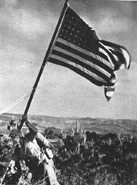The Battle of Okinawa started in April 1945. The capture of Okinawa was part of a three-point plan the Americans had for winning the war in the Far East. Okinawa was to prove a bloody battle even by the standards of the war in the Far East but it was to be one of the major battles of World War Two.
Alongside, the territorial re-conquest of land in the Far East, the Americans wished to destroy what was left of Japan’s merchant fleet and use airstrips in the region to launch bombing raids on Japan’s industrial heartland.
Okinawa is the largest of the Ryukyus islands at the southern tip of Japan. Okinawa is about 60 miles long and between 2 and 18 miles wide. Its strategic importance could not be underestimated – there were four airfields on the island that America needed to control. America also faced the problem that they had not been able to get much intelligence information about Okinawa.
The Americans estimated that there were about 65,000 Japanese troops on the island – with the bulk in the southern sector of the island. In fact, there were over 130,000 Japanese troops on the island with more than 450,000 civilians. The Japanese troops on the island were commanded by Lieutenant- General Ushijima who had been ordered to hold onto the island at all costs.
Ushijima decided on his tactics – he would concentrate his forces in the southern sector of the island and station his men in a series of secure fortifications. If the Americans wanted to take these fortifications, they would have to attack the Japanese in a series of frontal assaults. Alongside the land side Japanese defences, the Japanese high command put their faith in the kamikazes which it was believed would inflict such serious casualties on the Americans in Okinawa that they would retreat.
The Americans land commander was Lieutenant-General Simon Bolivar Buckner. He had 180,000 men under his command. The bay selected for the American landing was Hagushi Bay on the western side of the island. As with Iwo Jima, the landings were preceded by a period of intense bombardment but America’s forces were also open to attack from Japanese fighters flying out of Taiwan or Japan itself.
The attack on Okinawa was scheduled for April 1st 1945. In the days leading up to it, the Americans had landed some units twenty miles southwest of Hagushi Bay to secure an anchorage. By March 31st, this landing force, comprising of the 77th Division, had secured its position.
Kamikaze attacks were being experienced by the American navy anchored off of Okinawa. Out of the 193 kamikaze plane attacks launched against the American fleet, 169 were destroyed. Those planes that got through did caused a great deal of damage especially to America’s carrier fleet that did not have armoured flight decks – unlike the British carriers. However, the destruction of so many kamikaze flights did a great deal to undermine the potential for damage that the kamikazes could have inflicted.
For the actual invasion, America had gathered together 300 warships and 1,139 other ships. The first landing of Marines did take place on April 1st. They met little opposition and by the end of the day 60,000 American military personnel had landed at Hagushi Bay. By April 20th, all Japanese resistance in the north of the island had been eradicated except for some guerrilla activity.
The real battle for Okinawa was in the south of the island. On April 4th the XIV Corps (US 7th, 27th, 77th and 96th infantry divisions) ran into the Machinato line. This brought to a halt the advance of the Americans in the south of Okinawa. The Machinato line was finally breached on April 24th. However, it then had to confront the Shuri Line which further slowed the American advance. Together with the success of the kamikazes who had sunk 21 American warships and badly damaged 66 other warships, American forces experienced heavy losses.
On May 3rd, Ushijima ordered a counter-attack but this failed. By May 21st, Ushijima ordered his men to pull back from the Shuri Line. However, the resistance by the Japanese stood firm. It was only into June that it became obvious that the Japanese had lost the fight for Okinawa. On July 2nd, Okinawa was declared secure by the Americans – Ushijima had committed suicide some days before this.
|
The American flag planted in Okinawa |
The attack on Okinawa had taken a heavy toll on both sides. The Americans lost 7,373 men killed and 32,056 wounded on land. At sea, the Americans lost 5,000 killed and 4,600 wounded. The Japanese lost 107,000 killed and 7,400 men taken prisoner. It is possible that the Japanese lost another 20,000 dead as a result of American tactics whereby Japanese troops were incinerated where they fought.
The Americans also lost 36 ships. 368 ships were also damaged. 763 aircraft were destroyed. The Japanese lost 16 ships sunk and over 4,000 aircraft were lost.
Related Posts
- The Battle of Okinawa started in April 1945. The capture of Okinawa was part of a three-point plan the Americans had for winning the war…
